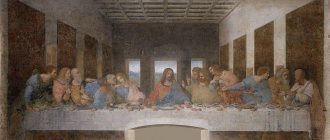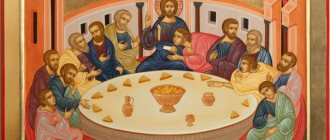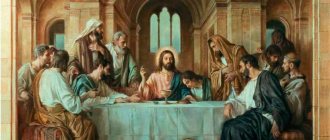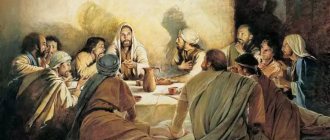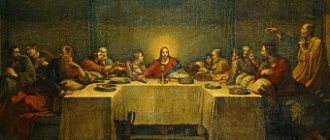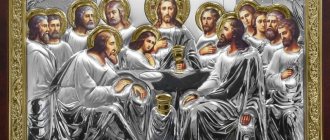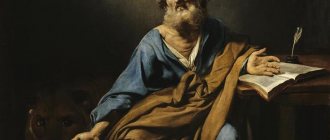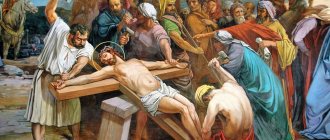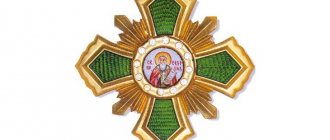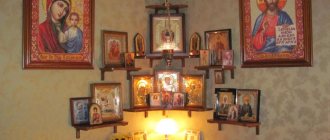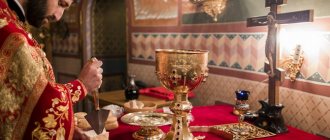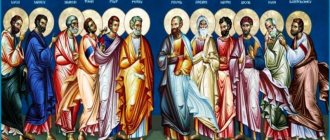Last Supper (1495-1498). Without exaggeration, the most famous wall painting. Although it is difficult to see her live.
It is not located in the museum. And in the same refectory of the monastery in Milan, where it was once created by the great Leonardo. You will only be allowed in with tickets. Which need to be purchased 2 months in advance.
I haven’t seen the fresco yet. But standing in front of her, questions would swirl in my head.
Why did Leonardo need to create the illusion of volumetric space? How did he create such diverse characters? Next to Christ is John or is it Mary Magdalene? And if Mary Magdalene is depicted, then who among the apostles is John?
Illusion of presence
Leonardo da Vinci.
Last Supper. 1495-1498 Monastery of Santa Maria delle Grazia, Milan, Italy. Wga.hu Leonardo intended to harmoniously fit his work into the surrounding environment. He built a perfect perspective. Real space smoothly transitions into depicted space.
The shadows of the plates and bread indicate that the Last Supper is illuminated from the left. There are just windows on the left in the room. The dishes and tablecloths were also painted the same as in the refectory itself.
Leonardo da Vinci. Last Supper. Fragment. 1495-1498 Monastery of Santa Maria delle Grazia, Milan, Italy
Another interesting point. To enhance the illusion, Leonardo demanded that the door be walled up. On the wall where the fresco was supposed to appear.
The refectory was very popular in the city among the townspeople. Food was carried from the kitchen through this door. Therefore, the abbot of the monastery insisted on leaving her.
Leonardo got angry. Threatening that if he does not meet him, he will write him as Judas... The door was walled up.
They began to carry food from the kitchen along long galleries. She was cooling down. The refectory no longer brought in the same income. This is how Leonardo created the fresco. But he closed the profitable restaurant.
But the result amazed everyone. The first spectators were stunned. The illusion was created that you were sitting in the refectory. And next to you, at the next table, is the Last Supper. Something tells me that this kept the diners from gluttony.
After some time the door was returned. In 1566, the refectory was again connected to the kitchen. Christ's feet were “cut off” by the new doorway. The illusion was not as important as the hot food.
Description of the plot and characters
Apostle Bartholomew is dressed in a gray-blue cloak over a green tunic.
James the Younger is depicted with long blond hair and a regular profile.
The Apostle Andrew will raise his hands in a gesture expressing doubt as to how true what Jesus said can be.
Judas clutches a bag of coins. He is the only one among the apostles who is not illuminated by light.
The Apostle Peter, with a frowning face, tightly clutches a knife in his right hand.
John is the youngest among the apostles. Depicted with a pale face and feminine features.
Jesus is depicted alone at the center of the painting as he faces his destiny alone.
Jacob the Elder spreads his arms in a gesture expressing his surprise at what he hears.
Apostle Philip presses his hands to his chest, expressing his heartache, innocence and devotion to Jesus.
The Apostle Thomas is depicted with his index finger raised. He gestures as if to show that the traitor will pay for everything.
Matthew extends his hands to the center of the stage and looks at the apostles, as if asking: “Did you hear what he said?”
Apostle Thaddeus is depicted in an orange tunic, with long gray hair.
The Apostle Simon, in bewilderment, raises his hands, palms up, and talks to Thaddeus.
The Last Supper, depicted by Leonardo, takes place in a spacious hall with a high coffered ceiling, three large windows at the back revealing a picturesque landscape, and four massive tapestries on the side wall. All architectural elements are combined in a geometric composition, the purpose of which is the illusion of “breaking through” the wall in order to artificially increase the space, as if the “Last Supper” was a continuation of the refectory.
The entire hall is occupied by a table covered with a white tablecloth, on one side of which Jesus and the apostles sit. Leonardo captures the moment in the Gospel of John when Jesus announces that one of the twelve disciples will betray him. His statement causes great excitement among all the apostles except Judas. The appearance of each of them expresses pain, distrust, amazement, and anxiety. In groups of three they are positioned around Jesus, who maintains calm, serenity and inexpressible static strength. He is depicted almost as a deity, rising above human imperfection and passions, which are embodied in the person of the apostles.
The subject is often found in the iconography of Christian art. In the 15th century, he is presented according to a specific pattern - with Judas isolated from the other characters on the opposite side of the table. But Leonardo changed this approach to avoid fragmentation and, as a result, a decrease in drama.
He places everyone on one side of the table, symmetrical to the figure of Jesus, realizing that betrayal is part of the divine plan, and Judas is just a tool in the hands of God:
- to the left (to the right of Jesus) – Bartholomew, James the Younger, Andrew;
- behind them are Judas, Peter and John;
- on the right (to the left of Jesus) – Thomas, James Zebedee (James the Elder) and Philip;
- the last group is Matthew, Judas Thaddeus and Simon the Canaanite.
Each of the disciples occupies a certain part of the space, which practically does not change from figure to figure (with the exception of Christ, who is located separately). There are several allusions to the “troika” (Holy Trinity) in the picture. Apostles in groups of three, three windows, the figure of Jesus forms a triangle. All images are illuminated by light coming from the left, with the exception of Judas Iscariot, who remains almost in shadow.
The first three from the left are Bartholomew, James the Younger and Andrew
Starting from the extreme left corner in relation to the viewer, Bartholomew, James the Younger and Andrew are located.
Bartholomew is a young man with curly brown hair and a faint beard on his face. He wears a gray-blue cloak over a green tunic tied at his right shoulder. Indignant, he stands up vigorously, resting his hands on the table and leaning forward towards Jesus.
James the Younger is a young man with long blond hair and a regular profile, with a hint of a beard, wearing an orange tunic with a blue outline around the neck. He sits facing the center of the stage. He places his right hand on the shoulder of Andrei, who is sitting next to him, while with his left hand, behind Andrei’s shoulders, he tries to reach Peter.
Andrey is an elderly man with sparse gray hair and a long beard. He wears an ocher tunic and a dark green cloak resting on his shoulders. He sits facing the center of the stage and holds his arms raised to chest level with his palms open as a sign of doubt about how true what Jesus said might be.
The second three – Peter, Judas and John
Peter is an elderly man, gray-haired, wearing a blue tunic with a yellow cloak on top, which has slipped off one shoulder. His face frowns, he leans forward and places his left hand on John's shoulder, asking who Jesus is talking about. The right hand, tightly gripping the knife, rests on the side.
Judas, a dark-haired man seated between Peter and John, clutches a bag of coins. Turning three-quarters to Jesus, he rests his right elbow on the table and knocks over the salt shaker in his excitement. With his left hand he reaches for the bread, which Jesus is about to take from the opposite side. Judas is dressed in a blue tunic and a green cloak, covering only the left side of his body. He is the only one among the apostles who is not illuminated by the light coming from the left.
John, the youngest of the twelve apostles, brother of James the Elder. His head is tilted towards Peter, his face is pale, his hands are crossed as in prayer and lie on the table. He listens to Jesus, whose words greatly upset him. John has long blond hair and feminine features. He wears a blue tunic and a pink cloak that covers the left side of his body.
To the right of Christ are Thomas, James and Philip
Jacob the Elder is a man in a green tunic with wavy brown hair that falls to his shoulders. He is depicted with his arms outstretched in a gesture that emphasizes his surprise at what he has just heard.
Thomas, nicknamed Didymus (Twin), behind James the Elder, is a man with a long face, a dark beard and thick curly hair. The viewer sees only the left side of his face in profile. He clenches his hand into a fist with his index finger raised, as if to say, “I swear, we will make him pay.”
Philip is a young man with long hair and a beardless face. He wears an orange cloak with a blue tunic underneath. He stands with his hands pressed to his chest in a gesture of heartache, expressing his devotion and innocence.
Closing the composition are the apostles Matthew, Thaddeus and Simon.
Matthew is a young man with brown hair and a faint beard who wears a tunic and cloak in shades of blue. He stands up and turns to Thaddeus and Simon, but his hands are extended to the center of the stage. He seems to be asking, “Did you hear what he said?”
Thaddeus is an elderly man with a beard and long gray hair wearing an orange tunic. He looks at Simon worriedly. His left hand is on the table, with his right hand he points to Jesus.
Simon is an elderly man, bald and with a gray beard, wearing a light tunic and a dark pink cloak. He talks to Thaddeus, raising his hands, palms up, in bewilderment.
Set table
The Last Supper is a ritual meal in honor of Passover, the Jewish Passover. Traditionally, it consisted of unleavened bread, charoset, bitter herbs, roast lamb and wine - what the Jews ate and drank before fleeing to Egypt.
Leonardo was inspired by the banquets of his time. In this way, the monks of the monastery could feel themselves present at the table with Jesus and the apostles.
On the table, covered with a “tablecloth from Perugia,” there is bread, pomegranate, and wine. There is fish in a dish to the left of the viewer. On the right is a dish of fried eel in a sweet and sour marinade (orange and pomegranate juice), garnished with orange slices, as identified by food historian John Varriano in 2008.
This is an unlikely food for Jesus and the apostles, given that eel is not a kosher food (no fins or scales) and oranges arrived from the Far East in the 9th century. But eel was a typical dish for the Lombard court and is described in the cookbooks of the time.
All objects: transparent wine glasses, pewter dishes, jugs of water - are depicted by Leonardo flawlessly and in detail, which anticipates the genre of still life, brought to perfection by the Dutch realist artists of the 17th century.
Artists adapted faces, clothing and settings to the places where they lived and worked. And Leonardo fills the table with food that is symbolic, recognizable and acceptable to the public. The pewter, glasses and tablecloth also encourage comparisons between the ancient table and the Renaissance table and testify to Leonardo's explorations of light.
Great job
When a work is ingenious, it seems that its creator had no difficulty in creating it. After all, that’s why he’s a genius! To release masterpieces one after another.
In fact, genius is in simplicity. Which is created by hard mental work. Leonardo stood for a long time in front of his work, thinking. Trying to find the best solution.
This irritated the already mentioned abbot of the monastery. He complained to the customer of the fresco. Ludovico Sforza. But he was on the master’s side. He understood that creating masterpieces is not the same as weeding a garden.
Long thoughts were not compatible with the fresco technique (painting on wet plaster). After all, it involves fast work. Until the plaster has dried. After which you can no longer make changes.
So Leonardo decided to take a risk. Applying oil paints to a dry wall. So he had the opportunity to work as much as he wanted. And make changes to what has already been written.
Leonardo da Vinci. Last Supper. Fragment. 1495-1498 Monastery of Santa Maria delle Grazia. Wga.hu
But the experiment was unsuccessful. After a couple of decades, the paint began to fall off due to dampness. For 500 years, the masterpiece was on the verge of complete destruction. And there is still little chance that our descendants will see it.
Damage and restoration
During its more than half a millennium existence, the fresco was damaged several times. And by the Dominican monks themselves, who cut off the lower part of the image along with the feet of Jesus and the closest apostles. And Napoleon's troops, who turned the church into a stable and threw stones at the heads of the apostles. And Allied bombs that exploded on the roof during World War II. After the damage was caused, well-meaning restorers tried to repair the damage, but the results were not very good.
Already at the end of the 20th century, a lengthy restoration removed all previous unsuccessful restoration attempts and corrected the damage caused to the fresco. But despite this, today’s “Last Supper” is just a shadow of the masterpiece created by the great painter.
The photo below shows a restored copy:
Psychological reaction
Such a variety of character reactions was not easy for the master. Leonardo understood that people with different characters react very differently to the same words.
He told funny stories or unusual facts to those gathered at the same table in taverns. And watched how they reacted. To then endow them with the gestures of their heroes.
And so we see how the 12 apostles reacted. To the unexpected words of Christ, “One of you will betray me.”
Leonardo da Vinci. Last Supper. Fragment. 1495-1498 Monastery of Santa Maria delle Grazia, Milan, Italy
Bartholomew rose from the bench and leaned on the table. This impulse shows his readiness to act. As soon as he hears who the traitor is.
Andrey has a completely different reaction. In slight fright, he raised his hands to his chest with his palms facing the viewer. Like, this is definitely not for me, I’m clean.
Here is another group of apostles. Already on the left hand of Christ.
Leonardo da Vinci. Last Supper. Fragment. 1495-1498 Monastery of Santa Maria delle Grazia, Milan, Italy
Jacob Zebedee was stunned by what he heard more than anyone else. He looked down, trying to comprehend what he had heard. Opening his arms, he holds back the approaching Thomas and Philip. Like, wait, let the Teacher continue.
Thomas points to the sky. God won't allow this to happen. Philip rushed to assure the Teacher that he could trust him. After all, he is not capable of this.
The reactions are very different. No one had ever depicted this before Leonardo.
You won’t see this even among Leonardo’s contemporaries. Like, for example, Ghirlandaio. The apostles react and talk. But somehow it’s too calm. Monotonous.
Domenico Ghirlandaio. Last Supper. 1486 Fresco in the Basilica di San Marco, Florence, Italy. Wikimedia.commons.org
The Mysteries of Jesus and Judas
As I already said, Judas is quite recognizable here, but, in addition to the wallet, one gesture also indicates the symbolism of his image. At the same time as Christ, he reaches out his hand to the food, which indicates a certain rivalry that the future traitor feels. It is not surprising that Leonardo worked the longest on these images. As biographers note, the master could not find suitable types.
As a result, the images were finally found. Leonardo based Jesus on a church choir singer, and used a drunken tramp as the prototype for Judas. However, there are art historians who claim that Jesus and Judas were painted from the same person. As you can see, da Vinci asks us a lot of riddles.
Judas, at the same time as Christ, reaches out to the food, clutching a wallet with money in the other hand.
The main mystery of the fresco. John or Mary Magdalene?
According to the official version, the Apostle John is depicted at the right hand of Christ. But he is depicted as so feminine that it is easy to believe in the legend about Mary Magdalene.
Leonardo da Vinci. Last Supper. Fragment. 1495-1498 Monastery of Santa Maria delle Grazia, Milan, Italy
And the oval of the face is purely feminine with a pointed chin. And the brow ridges are too smooth. Also long thin hair.
And even his reaction is purely feminine. What he/she heard made him/her feel uncomfortable. Helplessly, he/she clung to the Apostle Peter.
And his/her hands are folded limply. But before John was called by Christ, he was a fisherman. That is, those who pulled a multi-kilogram net from the water.
The Power of the Last Supper Composition
Despite its deplorable state, the beauty of Leonardo's Last Supper remains original, because it attracts with the highest intellectuality of its composition. The apostles look incredibly believable, as if they were bombarding Christ with questions: “What are you saying?”, “What do you mean by this?” One apostle looks at him with suspicion. Another group of apostles does not look at Jesus, but tries to understand the meaning of his words. Andrei raises his hands, Jacob points his finger, as if threatening, Thomas spreads his hands, stunned and irritated, Philip, again, with gestures, as if blaming: “I have done so much for you, I gave you my heart, and you treat me like this! "
But the most successful and emotionally intense group is the group with Judas. Judas has darker skin than the others and is the only frozen figure. While others are moving in excitement, Judas is calm, because he will do what he has to do.
The most unusual image is that of the Apostle John. The American writer Dan Brown, in his novel “The Da Vinci Code,” saw in him the image of Magdalena, but in fact, John had always been depicted next to Jesus and there was always a certain feminine grace in his features. The very presence of a woman in those days at a table where only men sat was a priori impossible. That is, the figure who bowed his ear to Peter’s lips, listening to what the apostle wants to tell him in secret, can only be John. Thanks to this composition, a perfect inverted triangle is formed between Jesus and John, a magnificent “V” that leaves Jesus alone. This separation of John from Jesus is a huge compositional innovation in such iconography.
Where is John?
John can be identified in three ways. He was younger than Christ. As we know, before his calling he was a fisherman. He also has a brother, also an apostle. So we are looking for someone young, strong and similar to another character. Here are two contenders.
Last Supper. Left: Bartholomew. Right: Matthew.
Although everything can be much more prosaic. The two characters resemble each other because the same person posed for the artist.
And John looks like a woman because Leonardo was inclined to depict androgynous people. Just remember the pretty angel from the painting “Madonna of the Rocks” or the effeminate “John the Baptist”.
Paintings by Leonardo da Vinci. Left: “Madonna of the Rocks” (fragment). 1483-1486 Louvre. Right: “John the Baptist.” 1516-1518 Louvre.
Choose for yourself what you like best. Believe in the legend of Mary Magdalene or adhere to the official version of art historians. This will not diminish the significance of the Last Supper.
After all, this is the only creation of Leonardo that has been available to people throughout the centuries. All other paintings were kept in private collections until the 19th century. And only their owners saw them.
Read about other masterpieces of the master in the articles:
“Mona Lisa. The mystery of Mona Lisa, which is little talked about”
“Madonna Litta. Unusual details of a masterpiece”
***
If my style of presentation is close to you and you are interested in learning painting, I can send you a free series of lessons by email. To do this, fill out a simple form using this link.
Comments
for other readers,
see below
. They are often a good addition to an article. You can also share your opinion about the painting and the artist, and also ask the author a question.
Author: Oksana Kopenkina
Go to home page
How to buy last minute tickets
How to see the famous fresco by Leonardo?
Having scoured the entire Internet and analyzed dozens of intermediary sites, I can recommend only one reliable site for buying tickets online “at the last minute” - this is www.getyourguide.ru
We go to the Milan section and select tickets costing from 44 euros with an English-language excursion - such tickets are on sale in about a week or two.
If you need to see the Last Supper urgently, then choose the option for 68 euros with a tour of Milan.
For example, on the evening of August 18, I managed to book tickets for August 21, while on the official website the next free window was not until December. The cost of 2 tickets with a group tour of Milan was 136 euros.
Working hours: from 8-15 to 19-00 with a break from 12-00 to 15-00. On pre-holiday and holiday days, the church is open from 11-30 to 18-30. Weekends: January 1, May 1, December 25.
Location and history of creation:
The famous fresco is located in the church of Santa Maria delle Grazie, located in the square of the same name in Milan. Or rather, on one of the walls of the refectory. According to historians, the artist specifically depicted in the picture exactly the same table and dishes that were in the church at that time. By this he tried to show that Jesus and Judas (good and evil) are much closer to people than they seem.
The painter received the order to paint the work from his patron, the Duke of Milan Ludovico Sforza in 1495. The ruler was famous for his dissolute life and from a young age was surrounded by young bacchantes. The situation did not change at all because the Duke had a beautiful and modest wife, Beatrice d'Este, who sincerely loved her husband and, due to her meek disposition, could not contradict his way of life. It must be admitted that Ludovico Sforza sincerely revered his wife and was attached to her in his own way. But the dissolute duke felt the true power of love only at the moment of the sudden death of his wife. The man's grief was so great that he did not leave his room for 15 days. And when he came out, the first thing he did was order a fresco from Leonardo da Vinci, which his late wife had once asked for, and forever stopped all entertainment at court.
Pictured is the Church of Santa Maria delle Grazie.
The work was completed in 1498. Its dimensions were 880 by 460 cm. Many connoisseurs of the artist’s work agreed that “The Last Supper” can best be viewed if you move 9 meters to the side and rise 3.5 meters up. Moreover, there is something to see. Already during the author’s lifetime, the fresco was considered his best work. Although, calling the painting a fresco would be incorrect. The fact is that Leonardo da Vinci wrote the work not on wet plaster, but on dry plaster, in order to be able to edit it several times. To do this, the artist applied a thick layer of egg tempra to the wall, which subsequently did a disservice, beginning to collapse just 20 years after the painting was painted. But more on that later.
The photo shows the Last Supper in the refectory.
